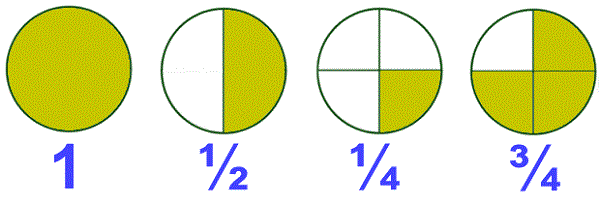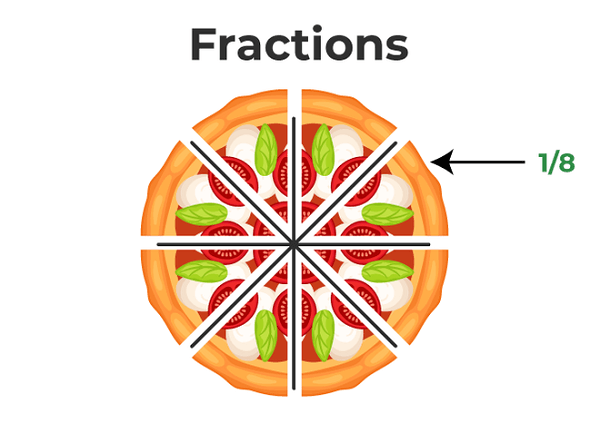Fraction DefinitionExplain Fractions
The First Definition of Fractions A fraction, a type of mathematical number, can represent the components of a whole. The Second Definition of Fractions A fraction is a numerical expression expressing a smaller proportion of a bigger number. Generally, a fraction can be a part of any amount taken from the whole, and the whole can be any particular item or value. The concepts of fractions explain a fraction's top and bottom numbers. The top number represents the total number of components, while the bottom represents the total number of pieces that may be chosen. If a number must be split into four pieces, it is then written as Fractions are Essential to Our Daily ExistenceFractions are a common thing in daily life. We have to share that tasty pizza with our loved ones, whether we want to or not. Three individuals, four slices. Learning and visualizing fractions in a simple method will be more enjoyable and thrilling. For example, if you cut an apple in half, each piece will be a fraction. (equivalent to Introduction to Fraction TypesA fraction is a piece or portion of any amount that is a part of the total, which might be any number, a specific sum, or an item. 
The two major components that determine a fraction's classification are its numerator and denominator. The two elements that make up a fraction are the numerator and the denominator. The numerator, the number placed at the top of the fractional bar, and the denominator, which is the number at the bottom, are both mathematical terms. The denominator represents the total number of components in the whole, whereas the numerator displays the number of parts taken into account. Fraction Types with ExamplesThere are various fractions, but the three most common varieties, which their numerator and denominator may distinguish, are listed here.
Let's examine each kind of fraction in further depth. 1. Proper Fractions A fraction whose numerator is smaller than its denominator is said to be a proper fraction. 2. Improper Fractions A fraction whose numerator is more than or equal to its denominator is said to be improper. For example 3. Mixed Fractions A mixed fraction is formed by combining a whole number and a legal fraction. For example, the numbers Is the correct fraction? In the second example, the correct fraction Fractional GroupVarious fraction kinds can be divided into categories. Comparing fractions is made easier by using groups of fractions. Here is a list of them.
Like Fractions When two or more fractions are comparable, their denominators are the same. For Example Unlike Fractions When two or more fractions are unlike each other, they have different denominators. For example Equivalent Fractions Equivalent fractions provide the same result when adjusted down or simplified, despite having multiple denominators and different numerators. For instance because they are all reduced to Key PointsThe following list includes some key points about the various fractional types. A fraction that combines a fraction and a full number is called a mixed fraction. A mixed fraction can become an incorrect fraction and the other way around. In this case We can determine that the value of a numerator in an improper fraction is higher than or equal to its denominator. It will always be more valuable than one for that reason. In a correct fraction, the numerator is always smaller than the denominator. Hence the value is never more than one. Are You Aware?Fractions with a numerator value of 1 and a denominator value of a positive integer are unit fractions. For example The ConclusionMathematical fractions and their many kinds are fundamental ideas. This post taught us about the many types of fractions, including equivalent fractions, mixed fractions, like and unlike fractions, proper and improper fractions, and mixed fractions, with examples.
Next TopicFracture Definition
|
 For Videos Join Our Youtube Channel: Join Now
For Videos Join Our Youtube Channel: Join Now
Feedback
- Send your Feedback to [email protected]
Help Others, Please Share





 . In this instance, the percentage
. In this instance, the percentage  of the number x. Thus, the fraction, in this case, is 1/4. It represents a percentage of one in four. It can be interpreted as
of the number x. Thus, the fraction, in this case, is 1/4. It represents a percentage of one in four. It can be interpreted as  ).
). and
and  are instances of appropriate fractions since 4<7 and 8<15, respectively. As an example, Arpita divided a stick into three equal pieces. She took one portion and handed her friend two others. The portions of Arpita and his friend can be shown as
are instances of appropriate fractions since 4<7 and 8<15, respectively. As an example, Arpita divided a stick into three equal pieces. She took one portion and handed her friend two others. The portions of Arpita and his friend can be shown as  respectively. These two fractions are the proper fractions in this situation.
respectively. These two fractions are the proper fractions in this situation. are improper fractions because 7 > 2 and 19 > 7, respectively.
are improper fractions because 7 > 2 and 19 > 7, respectively. are mixed numbers or fractions. The whole number component of the first example is 1, and
are mixed numbers or fractions. The whole number component of the first example is 1, and 
 and the whole number component are 2.
and the whole number component are 2. resemble fractions. Similar fractions may be easily combined to execute mathematical operations like addition and subtraction.
resemble fractions. Similar fractions may be easily combined to execute mathematical operations like addition and subtraction. etc. We can change, unlike fractions into like fractions to execute mathematical operations.
etc. We can change, unlike fractions into like fractions to execute mathematical operations. and
and they are comparable fractions.
they are comparable fractions.
 Units fractions include
Units fractions include  and so on.
and so on.




